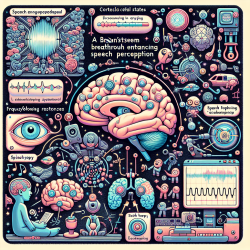Introduction
In the ever-evolving field of speech-language pathology, understanding the intricate workings of the brain can lead to groundbreaking advancements in therapeutic practices. Recent research titled "Brainstem speech encoding is dynamically shaped online by fluctuations in cortical ? state" offers new insights into how the brainstem and cortical states interact to influence speech perception. This blog aims to delve into these findings and discuss their implications for practitioners, particularly those involved in online therapy services like TinyEYE.
The Research at a Glance
The study explores the dynamic relationship between brainstem speech encoding and cortical states, particularly focusing on the frequency-following responses (FFRs) observed through EEG. The researchers found that brainstem speech coding is continuously modulated by cortical arousal and attention states, which are indexed by cortical ? power. This modulation is particularly evident in challenging listening environments, such as when background noise is present.
Key Findings
- Brainstem FFRs are stronger during high cortical ? power states, especially in noisy conditions.
- Low ? power states are associated with faster behavioral response times in speech detection tasks.
- Machine learning analyses revealed that speech representations are more accurately decoded from FFRs during low ? power states.
Implications for Practitioners
These findings have significant implications for speech-language pathologists, particularly those working with children in noisy environments such as classrooms. By understanding the role of cortical states in speech perception, practitioners can tailor their therapeutic approaches to enhance attentional and arousal states, thereby improving speech processing and comprehension.
Practical Applications
- Attention Training: Incorporate activities that enhance attentional focus, such as mindfulness exercises or targeted listening tasks, to improve cortical engagement during therapy sessions.
- Environmental Modifications: Minimize background noise during therapy to optimize brainstem encoding of speech, especially for children with auditory processing challenges.
- Biofeedback Techniques: Utilize biofeedback to monitor and adjust cortical arousal states, ensuring optimal conditions for speech perception.
Encouraging Further Research
While this study provides valuable insights, it also opens the door for further exploration. Practitioners are encouraged to engage in ongoing research and collaboration to refine these findings and develop innovative therapeutic strategies. By staying informed and proactive, speech-language pathologists can continue to enhance their practice and improve outcomes for children.
To read the original research paper, please follow this link: Brainstem speech encoding is dynamically shaped online by fluctuations in cortical ? state.










